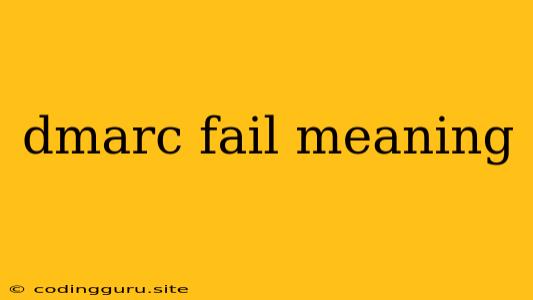What Does a DMARC Fail Mean?
In the vast and ever-evolving digital landscape, security and authenticity are paramount. Ensuring the legitimacy of emails is crucial for safeguarding both individuals and organizations from malicious activities. One critical mechanism for achieving this is the DMARC (Domain-based Message Authentication, Reporting & Conformance) protocol.
DMARC acts as a guardian, standing watch over your email domain and scrutinizing the authenticity of outgoing emails. It operates by verifying the sender's identity, ensuring that messages are not forged or spoofed. But what does it mean when you encounter a DMARC fail?
Understanding DMARC and its Fail States
DMARC works by examining two authentication protocols: SPF (Sender Policy Framework) and DKIM (DomainKeys Identified Mail). SPF verifies the sending IP address, ensuring that the email originates from a permitted server. DKIM verifies the sender's domain, using digital signatures to confirm the email's legitimacy.
When an email fails DMARC checks, it usually means one or both of these checks failed. This could be due to various reasons, including:
- Spoofed Sender: The email might be sent from a server not authorized by your SPF record.
- Missing DKIM Signature: The email lacks a valid DKIM signature, rendering it suspicious.
- Invalid DKIM Signature: The DKIM signature may be present but invalid, indicating potential tampering or forgery.
- Misconfigured DMARC Policy: Your DMARC policy may be too strict, leading to legitimate emails being flagged as failing.
What Happens When a DMARC Fail Occurs?
A DMARC fail doesn't necessarily mean the email is malicious, but it triggers a set of actions depending on your DMARC policy. These actions can include:
- Quarantine: The email might be placed in the recipient's spam folder, preventing it from reaching their inbox.
- Reject: The email is completely rejected and never delivered to the recipient.
- Monitor: The email is allowed to pass, but its details are recorded and reported to the administrator, allowing for analysis and potential future action.
How to Identify a DMARC Fail
Identifying a DMARC fail can be tricky for individuals, as email clients usually don't explicitly display DMARC status. However, administrators can use tools like email security platforms or DMARC reporting services to monitor the status of their domain. These tools provide detailed reports on the emails that pass or fail DMARC checks, offering valuable insights into their email security posture.
How to Fix a DMARC Fail
Fixing a DMARC fail requires pinpointing the root cause.
- Review your SPF and DKIM records: Ensure they are correctly configured and aligned with your domain's sending infrastructure.
- Check your DMARC policy: If it's too strict, consider relaxing it slightly to accommodate legitimate emails.
- Use a DMARC reporting service: Analyze reports to identify patterns and pinpoint areas for improvement.
The Importance of DMARC and its Fail States
DMARC is an invaluable tool for combating email spoofing and phishing attacks, ensuring the legitimacy of emails and protecting users from harm. DMARC fail states serve as a critical feedback mechanism, providing insights into potential security vulnerabilities and guiding organizations in their ongoing email security journey.
Conclusion
Understanding the meaning of a DMARC fail is crucial for organizations to effectively manage their email security posture. By implementing a robust DMARC policy and diligently addressing fail states, organizations can fortify their email infrastructure, bolster their security stance, and safeguard their reputation.
